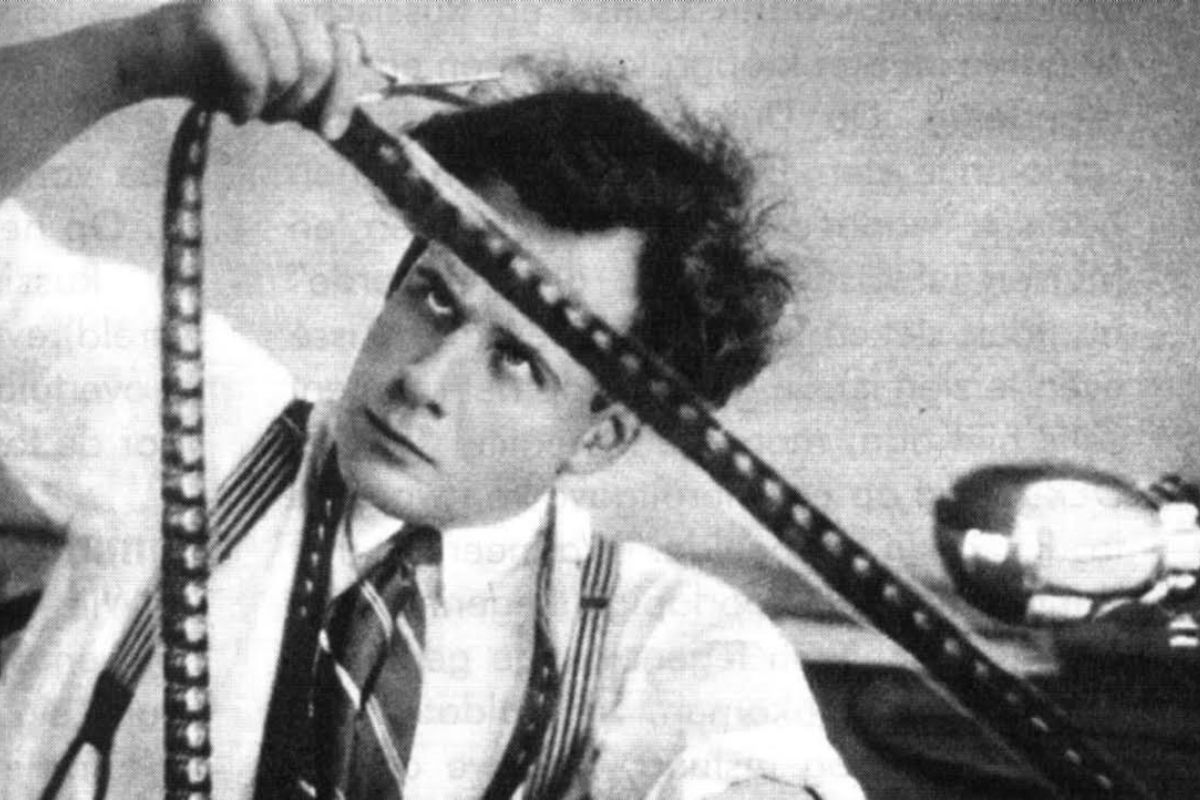In the pulsating heartbeat of cinematic history, Sergei Eisenstein emerges as the maestro of montage, the czar of cutting and the orchestrator of images that dance in unconventional rhythm across the silver screen. Eisenstein, with his avant-garde spirit and a penchant for neoteric fervour, carved his name into the annals of film history with a chisel made of juxtaposed frames. Let’s take a journey through the brilliance of Eisenstein’s cinematic chessboard, where every move is a stroke of genius, and the pieces are rearranged to compose a symphony of visual poetry.
Sergei Mikhailovich Eisenstein, born on 23 January 1898, in Riga, Latvia, was a pioneering force in the realm of cinema, forever altering the landscape with his visionary approach to filmmaking. In his formative years, Eisenstein’s childhood, shaped by the stern influence of both his father and Joseph Stalin, steered him towards seeking solace in artistic pursuits. Early on, he found refuge in creating drawings that depicted a utopian world and reflected his fascination with the circus. Despite this creative inclination, his aspirations were momentarily halted when his painting professors deemed him lacking artistic talent. Subsequently, in July of 1915, Eisenstein redirected his path, enrolling in the Institute of Civil Engineering in Saint Petersburg, Russia, aligning himself with his father’s profession as an engineer and architect. By 1918, however, Eisenstein’s trajectory took a different turn as he left his academic pursuits to enlist in the Red Army. Tasked with providing entertainment for the troops, he discovered a profound passion for the world of theatre. In 1920, he took a pivotal step in this direction by joining Moscow’s Proletkult Theater as an assistant director. Balancing his newfound passion with his academic background, Eisenstein published a seminal article in 1923 for LEF (Left Front of the Arts) titled “The Montage of Attractions”, marking the inception of his theoretical contributions to the cinematic landscape. Eisenstein articulated his concept of the “montage of attractions”, emphasising the selection of images to elicit a maximum psychological impact, laying the groundwork for his cinematic philosophy. These principles continued to shape Eisenstein’s filmmaking throughout his career, although the outcomes of his experimental endeavours were met with varying degrees of success.
Advertisement
The revolutionary vehemence of the times found its cinematic expression in his landmark work, “Battleship Potemkin” (1925), a film hailed for its groundbreaking use of montage to evoke emotional and ideological impact. Eisenstein’s career unfolded against the backdrop of the tumultuous Soviet Union, where he navigated the challenges of artistic expression amid political turbulence. His cinematic legacy endures as a testament to the power of innovation, daring to break conventions and rewrite the language of film.
Advertisement
Use of Montage in Eisenstein’s cinema
“The montage is an idea that arises from the collision of independent shots.”
Montage (meaning ‘assembly’ or ‘editing’ in French), a technique championed by Sergei Eisenstein, is a dynamic and versatile tool in filmmaking that involves the seamless juxtaposition of various shots to convey a specific idea, theme or emotion.
Across the expansive tapestry of film and video history, there exists arguably no cinematic or editing method more universally acknowledged and influential than the montage. Eisenstein himself explored different types of montage in his state-of-the-art cinematic works. Enthusiasts of the silver screen witness its presence in nostalgic blockbusters from the 1980s and 1990s like “Bloodsport” and “Dirty Dancing”. Its impact reverberates in revered cinematic masterpieces such as “The Godfather” and “Citizen Kane”. The classical origins of this technique are discernible in works like “Battleship Potemkin” (1925), and its enduring essence is both recreated and paid homage to in films like “The Untouchables” (1987).
Let’s take a few examples to illustrate how Sergei Eisenstein’s mastery of different montage techniques contributed to the unprecedented impact of his films and cemented his legacy as a pioneer in cinematic storytelling.
Metric Montage: This type of montage relies on the precise measurement and rhythmic arrangement of shots. The duration of each shot is determined by a specific metric, creating a sense of tempo and pacing that contributes to the overall emotional tone of the scene. Irrespective of the specific content within each clip, they share an equal measure, simultaneously intensifying to generate tension and preserving the initial contextual essence of the images. His use of metric montage in “October: Ten Days that Shook the World” (1927) is evident in sequences depicting the October Revolution. The flow of images creates a sense of momentum, capturing the spirit of historical upheaval through a visually compelling and rhythmically charged narrative.
Rhythmic Montage: Building on the musical analogy, rhythmic montage emphasises the visual cadence and flow of images. The editing is synchronised with a specific rhythm, evoking a visceral response from the audience. Put differently, shots and actions are aligned to sustain the inherent structure of the scene. This montage, however, doesn’t adhere to a specific rhythm or beat. In the film “Battleship Potemkin”, Eisenstein employed rhythmic montage to perfection in the iconic Odessa Steps sequence. The rhythmic cutting of shots, precisely timed to the beats of the musical score, intensifies the emotional impact of the unfolding tragedy. The rhythmic editing, dictated by the relentless tempo of the musical score, intensified the emotional impact of the unfolding massacre. Each cut was meticulously timed, creating a pulsating visual experience that heightened the tension and urgency of the scene.
Tonal Montage: Tonal montage is all about capturing the emotional essence of a scene. It involves assembling shots based on their emotional tone, creating a cohesive and powerful emotional impact. This type of montage aims to elicit specific feelings from the audience by carefully arranging images with complementary emotional resonance. According to Eisenstein’s “Film Form”, tonal elements in a film are rooted in the distinct emotional resonance or dominant theme of a piece. In simpler terms, tonal elements encompass the comparative aspects in visuals, sound and more that persist from one scene to the next. Eisenstein illustrates this concept by referring to the ‘fog sequence’ in “ Battleship Potemkin”, highlighting it as a poignant visual representation of the dominant tone and emotional sound, particularly in connection to Vakulinchuk’s funeral.
Overtonal Montage: Overtonal montage amalgamates elements from metric, rhythmic and tonal montage. This coexistence gives rise to a conflict between the primary tone and the secondary overtone, ultimately shaping a montage that revolves around the incorporation of thematic elements. Going beyond individual scenes, overtonal montage involves connecting sequences or acts in a film. It seeks to create a broader emotional resonance by linking the tones of various parts of the narrative. This technique enhances the overall thematic cohesion of the film.
Intellectual Montage: Eisenstein was particularly fond of intellectual montage, wherein the juxtaposition of shots is designed to stimulate intellectual and ideological responses from the audience. By combining seemingly unrelated images, filmmakers can encourage viewers to draw connections and reach conclusions independently. Eisenstein’s “Strike” (1925) features instances of intellectual montage, where he juxtaposes seemingly unrelated images to convey broader ideological messages. One notable example involves the parallel editing of factory machinery and animal slaughter. The deliberate juxtaposition of the scene depicting workers being attacked and another featuring a bull being slaughtered forms a cinematic metaphor implying that the workers are being dehumanised, akin to the treatment of cattle. This symbolism emerges not from the individual shots themselves but materialises only through their intentional juxtaposition.
Eisenstein elaborated on the application of this theory, citing a prime illustration in his film “October”. In a specific sequence, the concept of ‘God’ is intricately linked to class structure, where images carrying overtones of political authority and divinity are skillfully arranged in descending order of impressiveness. This deliberate editing culminates in associating the notion of God with a seemingly ordinary block of wood. Eisenstein contended that this sequence was designed to prompt an automatic rejection of all political class structures in the minds of the viewers.
Sergei Eisenstein’s montage techniques remain the conductor orchestrating a symphony of visual brilliance in the grand reel of cinematic innovation. From rhythmic beats to tonal resonance, Eisenstein’s legacy is a montage masterpiece, a collage of creativity that continues to inspire filmmakers to cut, juxtapose and create their own cinematic poetry. So, as the credits roll on this exploration of Eisenstein’s techniques, tip your hat to the maestro himself – the maestro who made the montage not just a cut above, but a cinematic checkmate.
Advertisement











